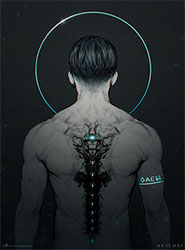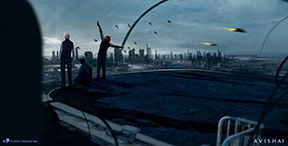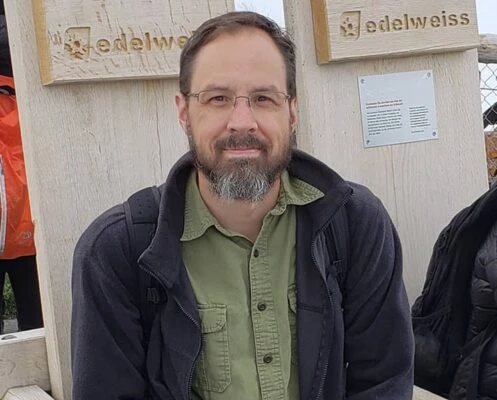
This month’s cover art comes from artist and designer Clarissa Ferguson. Ferguson enjoys all forms of art and design. She took time out of her busy schedule as a student at the Savannah College of Art and Design to give Apex Magazine insight on her methods.
APEX MAGAZINE: Your cover piece for this month, “Avishai - Elysha Fayanna,” ignites the viewer’s interest in discovering more about the story and who this intriguing character is. How much of the story, before or after the events shown, do you have in mind when you are creating a piece like this? Do digital techniques allow you more ability to explore the idea before finalizing it?
CLARISSA FERGUSON: When I create a piece, usually the story I have about the character or world that they are in is already pretty detailed. When I make an illustration, I am only highlighting a point in time in that story that I wish to convey to the viewer. I feel as though I have so many stories swimming in my mind that some of them stick around for a short time, but a few of them I actually spend a long time refining. “Avishai” is one of those stories that stayed with me for a long time. It started with my first ever picture of my main character Shin called, “Shin.” I made this piece over two years ago as an anatomy practice, but somehow looking at this character brought a spark of inspiration. Over time he just evolved, and the world around him expanded so much that I knew I reached the point where I needed to bring this story to reality.
With almost every piece I have made in my online galleries (some a part of “Avishai” and some not), there is usually a story to be told. I believe digital techniques did help in improving my abilities and finalizing my ideas, but Photoshop (the program I use) is only a tool, artists still need to learn and practice the fundamentals of art in order to have a good foundation. Knowing how to properly use that tool, I am able to really make a strong impact with my art.
AM: On your Behance page, you mention your education in graphic design. How are the ideas and methods you use or have learned through graphic design influential to your illustrations? Vice versa, do your illustration methods also influence your design pieces?
CF: I believe my illustration methods influence my graphic design pieces greatly. Graphic design and illustration are different branches but they are a part of the same tree. They both are wonderfully creative fields to get into because your personality, skill, and creativity can shine through both! Also, to me, graphic design is a form of art and some of the concepts that I learned from doing illustration work can be applied to it, for example: color, composition, shape, line, and even texture all still can be applied to graphic design. Learning the basics about illustration were the stepping stones that helped me to easily get into graphic design.
AM: The pieces throughout your ArtStation portfolio seem balanced between fantasy and science fiction. Are there certain styles or techniques you use to push the viewer towards a specific fantasy or technical idea? How much freedom of interpretation should viewers have to decide if something fits in a certain genre?
CF: My style focuses mostly on realism. I strive to make a believable and imaginative world for my viewers because I want my work to tell a story without having to give too much of an explanation. As for genre, I try to layout plainly what genre my pieces fit into; most of my work is a mix of fantasy and sci-fi together but usually one genre shines more than the other. Using “Avishai - Elysha Fayanna” again as an example, the piecedepicts Elysha, one of my main characters, being transfixed by a powerful artifact. The viewers can try to interpret for themselves what the artifact could be or what is happening in the piece. It can lean towards fantasy, but her story is also based off a sci-fi type of universe. Another piece, “Shin’s Back Design - Cover Art,” depicts another one of my main characters, Shin, showcasing an odd device on his back. Again, I try not to reveal too much about it, but it is something that is out of place that would make the viewers scratch their heads a little. That piece is heavily leaning towards sci-fi. Mostly, I try to keep my explanation to a minimum when it comes to my personal project Avishai, my graphic novel in the works. I do not want to spoil anything; the viewers must wait until the story comes out!
AM: Many of your pieces feature very bright arcs of energy, bringing the viewer’s eye right to those spots. Are those bright areas more about the story of the character and the events unfolding, or do they serve more in a design sense to direct where you want the viewer to concentrate on? Or is it a bit of both?
CF: I’d say it is a bit of both because it does take a lot of planning to create an impactful illustration. I have never really created a piece spontaneously or on impulse. I take the time to plan out what I want to showcase and what type of story I am telling. Even when I would be doing my daily drawing exercises, I would write down in my little planner what I wanted to work on for each day. I believe my careful planning is what makes the creation of my pieces successful. However, I still have a lot of training to do so I can continually make my work the best that it can be.
AM: A few of your pieces, like “Hanging Out,” are driven more by the vast scenery than the more character-driven art featured in the rest of your galleries. What are the challenges of bringing a sense of character to a larger environment versus concentrating on only one or two characters?
CF: When people watch movies or play video games, they aren’t only there just to see the characters. Even though characters are an important part of a story, the environment helps to push the world the characters are established in. Environments can be challenging and even intimidating for some artists; there are many little elements that can be happening in a scene that can appear extremely difficult to create.
Recently, I had the pleasure of taking a self-taught course at an online art school called Schoolism. I learned how to paint environments a bit better from one of my favorite environmental artists, Nathan Fowkes. When I took his class, I was terrified about learning how to create environments, but I knew that creating environments was essential for telling a good story. He broke down the process so easily, and over time I understood how environments can actually tell a greater story than the characters themselves. They can have just as much personality and can change the mood of a scene easily. In the future, I plan on doing more environmental pieces to give my portfolio more of a variety. Plus, when creating a graphic novel, I can’t skip out on drawing a scene, there is no escape from it.
AM: Many thanks to Clarissa for the wonderful interview. See more of her designs and illustrations on her website at clarissaferguson.com, and make sure to follow her on her Instagram or her Facebook page.











